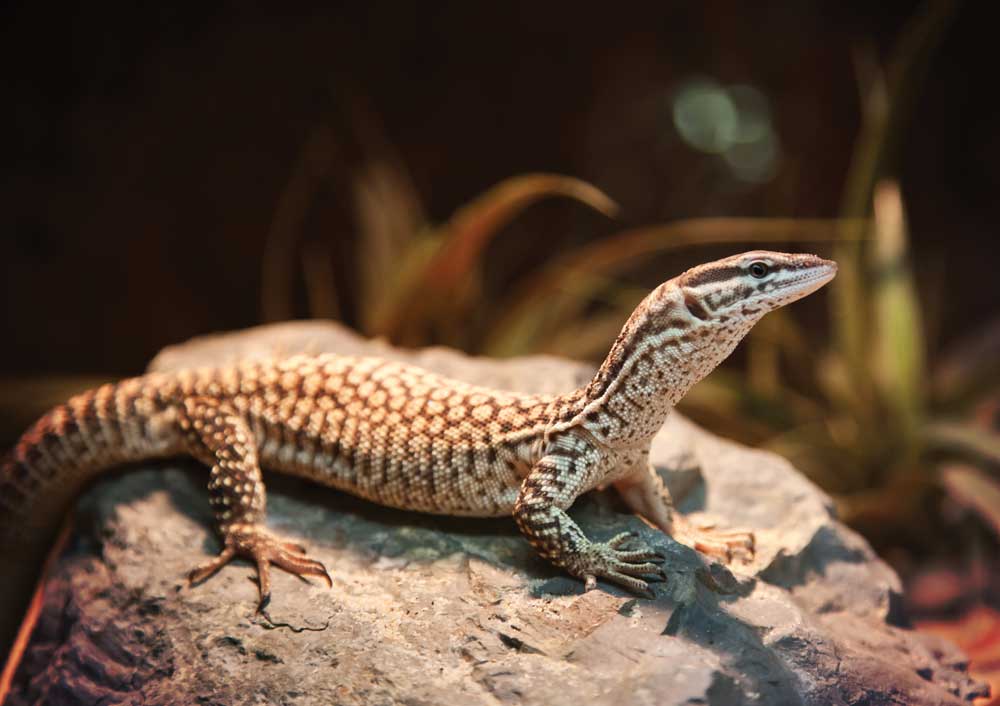the Ackie monitor's small size compared to their larger cousins makes housing one more reasonable, and despite being small, they still possess the innate charm and personality of a monitor lizard.
Monitor lizards are among the most extraordinary groups of lizards. Their intelligence, high prey drive, and hardy nature make them very alluring pets for reptile keepers. Among the most reasonable of the varanids is the spiny-tailed monitor, better known as the Ackie monitor (Varanus acanthurus). It is a beautifully colored monitor that lives in the northwestern territories of Australia as a primarily terrestrial reptile with occasional semi-arboreal activity that feeds on insects and other reptiles. The name “Ackie” originates from its species name acanthurus and its common name derives from the scaly spines down on its tail. When retreating into their burrows, these reptiles will inflate their lungs and block the entrance of their burrows with their tails as a defense mechanism. This species is part of the subgenera of varanids known as Odatria (aka the dwarf monitors) which comprises the small monitors that inhabit Indonesia and Australia. (1)
In recent years, this species has grown in popularity, and for good reason. Their small size compared to their larger cousins makes housing one much more reasonable, and despite being small, they still possess the innate charm and personality of a monitor lizard. Ackies also have different regional variants, with some being red and others being yellow. This provides incredible variety in their appearance and provides many color options.
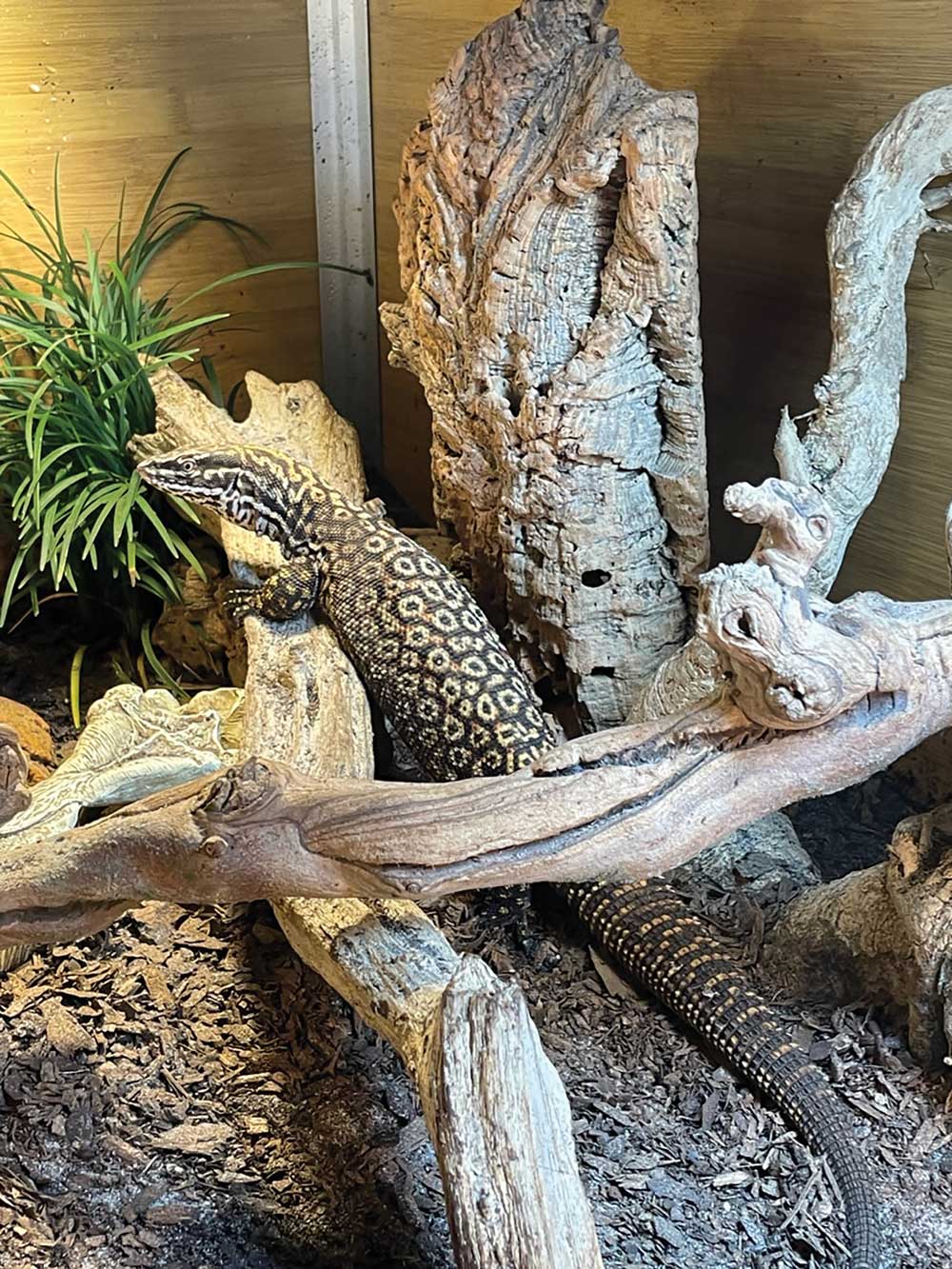
Provide your ackie with a few climbing branches. Photo by Eric Los Kamp, DVM
Their personalities, when properly socialized, are unparalleled and they can develop strong bonds with their owners, almost like that of a dog or cat. Additionally, all Ackies are captive-bred, meaning the issues and potential complications of wild-caught specimens such as parasitic infection, emaciation, fear of humans, and others are diminished. This means that you are more likely to get a healthy lizard. This article discusses in detail the husbandry of Ackies to ensure that your animal lives a long, fulfilling life.
Where to Find an Ackie Monitor
As previously stated, the Ackies in the pet trade are all captive- bred individuals. Thus, one of the best ways to acquire an Ackie is through a reputable breeder, of which there are many. You can also occasionally see Ackies at local reptile specialty pet shops and reptile expos. Regardless of where you get your monitor, I always recommend getting a visual of the animal, whether that is in person or through a video. You want your potential Ackie to be in good body condition with appropriate movement and activity levels. Additionally, if the breeder/supplier can bring the animal to a qualified reptile veterinarian for an exam before purchase that will ensure that the animal you are getting has a clean bill of health.
Ackie Monitor Enclosure
As monitor lizards, Ackies require substantial space to be able to explore. While the type and size of the enclosure can vary, there are several things that need to be met.
Regarding enclosure type, enclosure materials need to be able to retain heat and humidity. Ideal enclosure materials include PVC and wood. With wood, care needs to be taken to treat the wood first before placing the substrate so the enclosure does not rot. Additionally, Ackies tend to do better when the sides of the enclosure are covered.This can help acclimate a skittish Ackie to its new home and reduce stress. Due to these factors, glass is not an ideal enclosure for an Ackie.
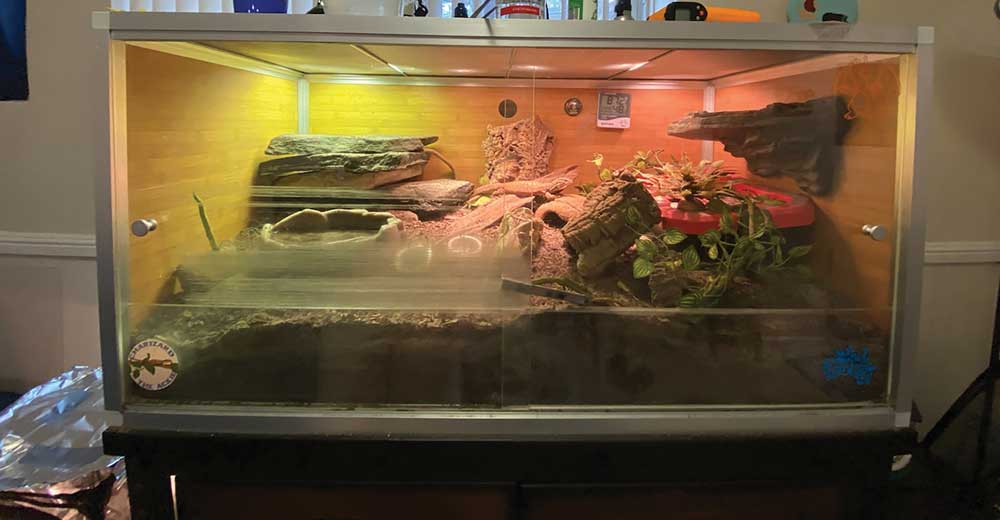
You can start your ackie in a 4’x2’x’2 enclosure. As it grows, so should the enclosure. Photo by Eric Los Kamp
As long as the environmental parameters of the animal are met, there can be variation in the other aspects of the enclosure. Ackie enclosures can have screen tops with lights on top of the grate, or can be solid with the lights inside. From personal experience, I have found that the solid enclosures do a much better job maintaining heat and humidity, as less bulbs need to be used. However, having the lights in the enclosure does reduce the climbing space of the enclosure, especially in shorter enclosures. Screen top enclosures need to be modified to reduce heat and humidity loss, but they can provide more opportunities for climbing and substrate.
Enclosure size can vary, but the most important issue is maximizing enclosure space. Start with a 4’x’2’x2’ or 5’x2.5’x3’ enclosure and go bigger from there as they grow. Ideally, the largest enclosure you can provide is best practice. Smaller enclosures can be modified to maximize the space available, such as making the walls climbable and providing a dig box if a deep substrate layer cannot be provided throughout the entire cage.
Enrichment items to add to an Ackie enclosure include slate rock, multiple climbing branches, cork tubes, rock ledges/climbable backgrounds, multiple hides, and a water bowl deep enough for the Ackie to soak in but heavy enough not to be flipped over. I have always had great success with utilizing slate rock for my basking spots, as they hold heat very well. Climbing branches are key for providing enrichment and exercise for your Ackie.
Cork tubes fill this role and also serve as an area of refuge for your Ackie. In my most recent Ackie’s enclosure, I have buried the cork tubes into the dirt to promote burrow formation. You can also attach cork rounds to the walls, providing additional dimension to both hides and climbing, which function similarly to magnetic rock ledges and climbable backgrounds. Hides are vital to ensure your Ackie has places to retreat to if stressed. I always try to partially bury the entrance of the hide to promote burrowing behaviors.
Substrate
As a fossorial species, Ackies require deep substrate layers in order to be healthy. In the wild, they can easily dig to depths of 1.3 feet for constructing their burrows (2). Thus, a minimum of one foot of substrate is recommended. This can be provided throughout the entire enclosure or in a localized area such as a dig box. Regardless, the best substrate for Ackies is a mixture of organic topsoil and washed play sand mixture. The ratio can vary, but most importantly the top layer needs to remain dry and the deeper layers moist. Ackies get a lot (~70%) of their hydration from humid air via pulmocutaneous exchange, so providing this depth of substrate is important for their overall health.(3) This is supported by Dav Kaufman’s observations of humidity in wild Ackie burrows, where they can reach >90% relative humidity (RH). Digital probe thermometers/hygrometers buried into the substrate can be used to monitor substrate humidity. Cycling the substrate to reduce the buildup of fungi/bacteria should be performed regularly.
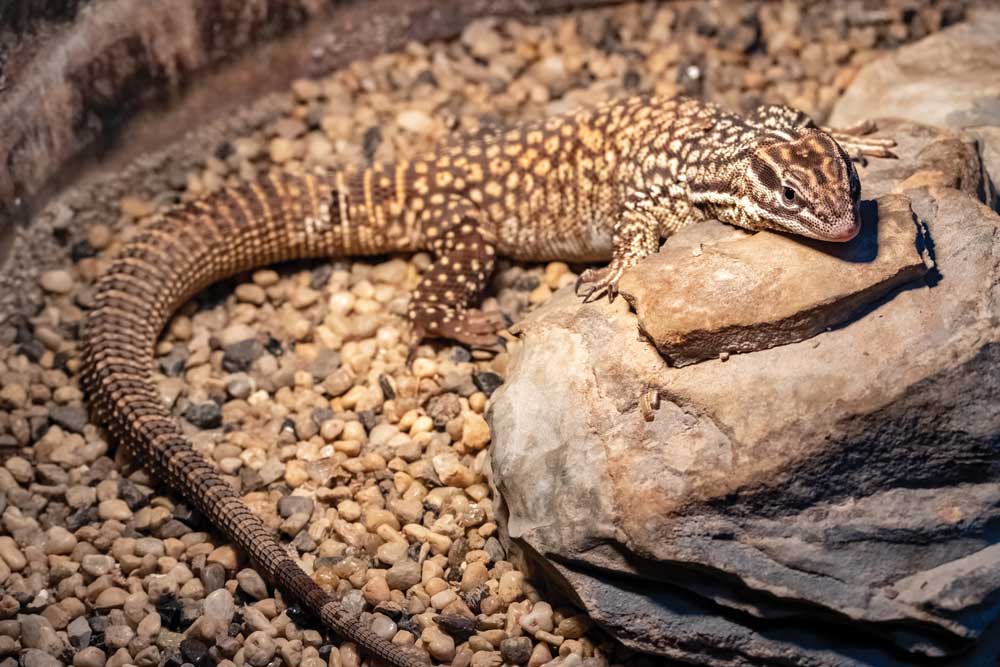
As a fossorial species, Ackies require deep substrate layers in order to be healthy. Photo by Pavel Filatov/Shutterstock
For the amount of substrate the enclosure needs, it is highly recommended to convert enclosures to bioactive set ups. When choosing plants for your enclosure, you need to be careful to ensure the plants you are choosing are not toxic. Even though Ackies do not eat plants, if the insects eat the plants, they can sequester toxins in their body that then can be passed to your Ackie. I have found that grasses such as Mundo grass are great additions to Ackie enclosures as long as they are not too close to the basking spots. When it comes to the cleanup crew (CUC), a wide variety of invertebrates can be used. I personally have had great success with dwarf white Isopods and springtail species. You can add other invertebrates such as superworms; however, the beetles will propagate uncontrollably and can overrun an enclosure.
Temperature and Lighting
As diurnal Australian reptiles, Ackies require very hot basking spot temperatures. However, an ideal basking spot should provide a gradient of multiple basking spot temperatures, so that the animal can choose an appropriate temperature it wants to be at. This can be accomplished with the utilization of a Rete’s stack (rock or plywood with spaces in between), slaterock, or wooden branches of varying distances from the basking spot. The temperature range of this basking spot should be between 120 to 150 degrees Fahrenheit (48.9 to 65.6 degrees Celsius), and this should be monitored with an infrared temperature gun.
Every Ackie is going to have a different preferred basking spot temperature, thus you need to monitor your animal’s basking behaviors to ensure you have the appropriate thermal gradients. Ackies are intermittent baskers, meaning they will spend small periods of time basking in between their normal daily movements. If your Ackie is basking for prolonged periods of time or avoids the basking spot, you would need to increase or decrease the basking spot temperatures, respectively.
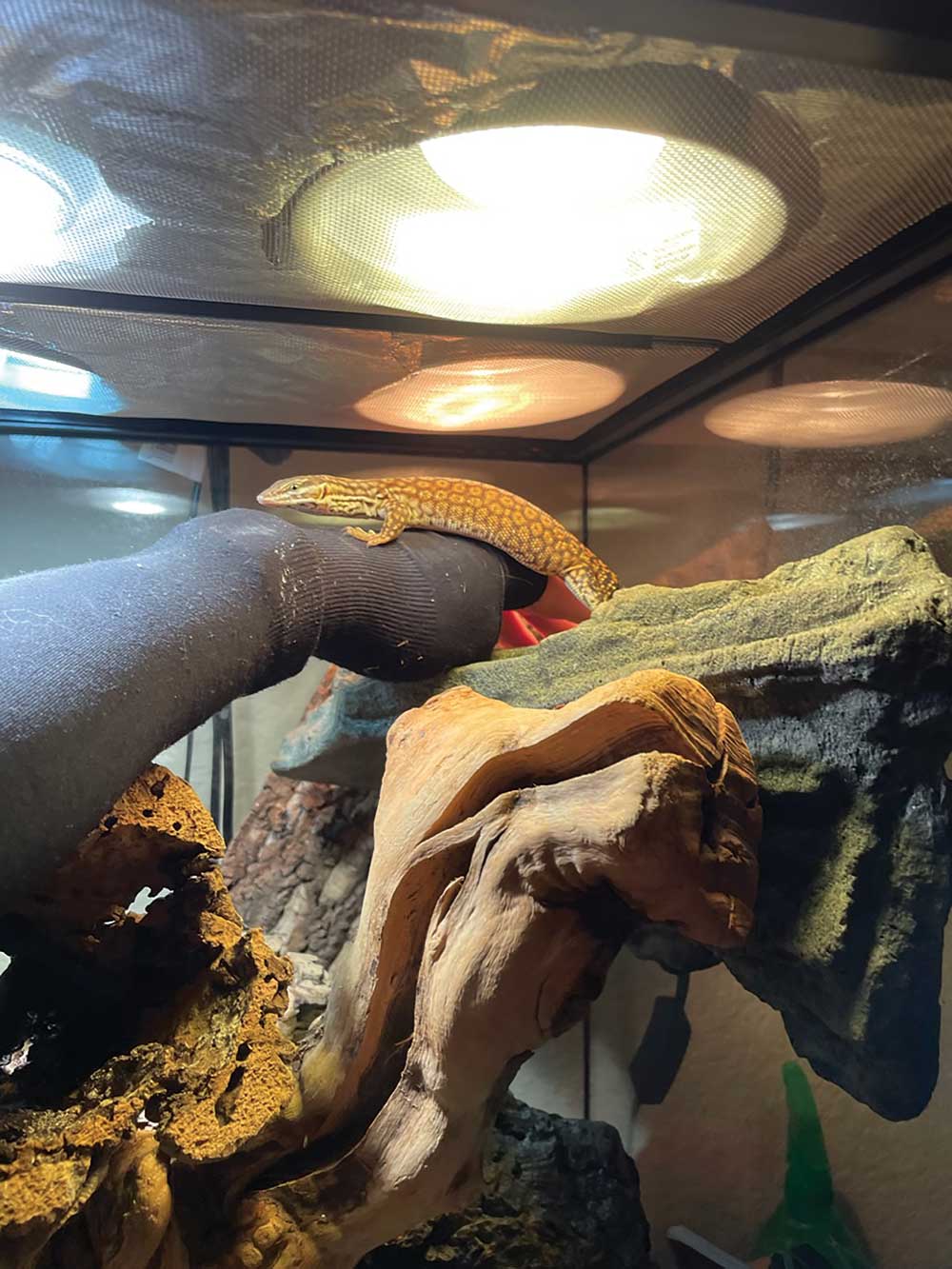
Provide several basking levels so your ackie can choose which is its favorite basking spot at any particular time. Photo by Eric Los Kamp
For ambient temperatures, in their native ranges Ackies typically will experience temperatures ranging from 59 to 90 degrees Fahrenheit (15 to 32.2 degrees Celsius). (3) For the enclosure, recommended ambient temperatures should range from 80 to 85 degrees Fahrenheit (26.7 to 29.4 degrees Celsius), with areas closer to the basking spot reaching 90 degrees Fahrenheit (32.2 degrees Celsius). Ambient temperatures should be monitored with multiple digital thermometers/hygrometers on both the warm and the cool side of the enclosure to ensure proper thermal gradients.
As a diurnal reptile of open environments, ultraviolet (UV) supplementation is mandatory. The Ackie monitor is a partial/open sun basker/Ferguson Zone 3 reptile with a UVI zone range of 1.0 to 2.6 and a maximum UVI of 2.9 to 7.4 in the basking zone. UVB supplementation can be provided in a variety of different ways, from LED tubes or fluorescent bulbs to mercury vapor bulbs. I have used a combination of all of these in various enclosures, and all of these bulbs have their pros and cons.
In my most current set up, I have a 10.0 LED tube that extends half the enclosure length. Overall, I feel the LED tubes provide the best coverage of UVB supplementation for Ackies. Regardless of the type of UVB bulb used, providing areas where your Ackie can escape the UVB lighting is crucial as well, hence why I do not recommend having full cage UVB lighting. All UVB bulbs must be replaced according to the manufacturers recommendations to ensure optimal output.
Besides UVB supplementation, providing LED bulbs are also crucial for illuminating enclosures, as heat bulbs and UVB lighting alone may be insufficient to fully illuminate an enclosure. Regardless of the light fixtures used in an enclosure, Ackies should be provided a 12 hour day/night cycle to promote healthy circadian rhythms and natural environmental cycling.
Ackie Monitor Humidity
While the ambient humidity of the habitats Ackies live in tend to be low, they are not exposed to these low humidity levels chronically. Chronic exposure to low humidity levels (30% RH or less) can lead to dehydration and renal disease. As stated earlier, their burrows are actually areas of high humidity, and Ackies will often find humid microclimates to spend their time. (4) Thus, I strive to maintain humidity gradients of 50 to 80% RH during the day, with substrate and nighttime humidity approaching greater than 90% RH. Humidity should be monitored with multiple digital thermometers/hygrometers on the warm and cool side of the enclosure to ensure appropriate gradients are maintained.
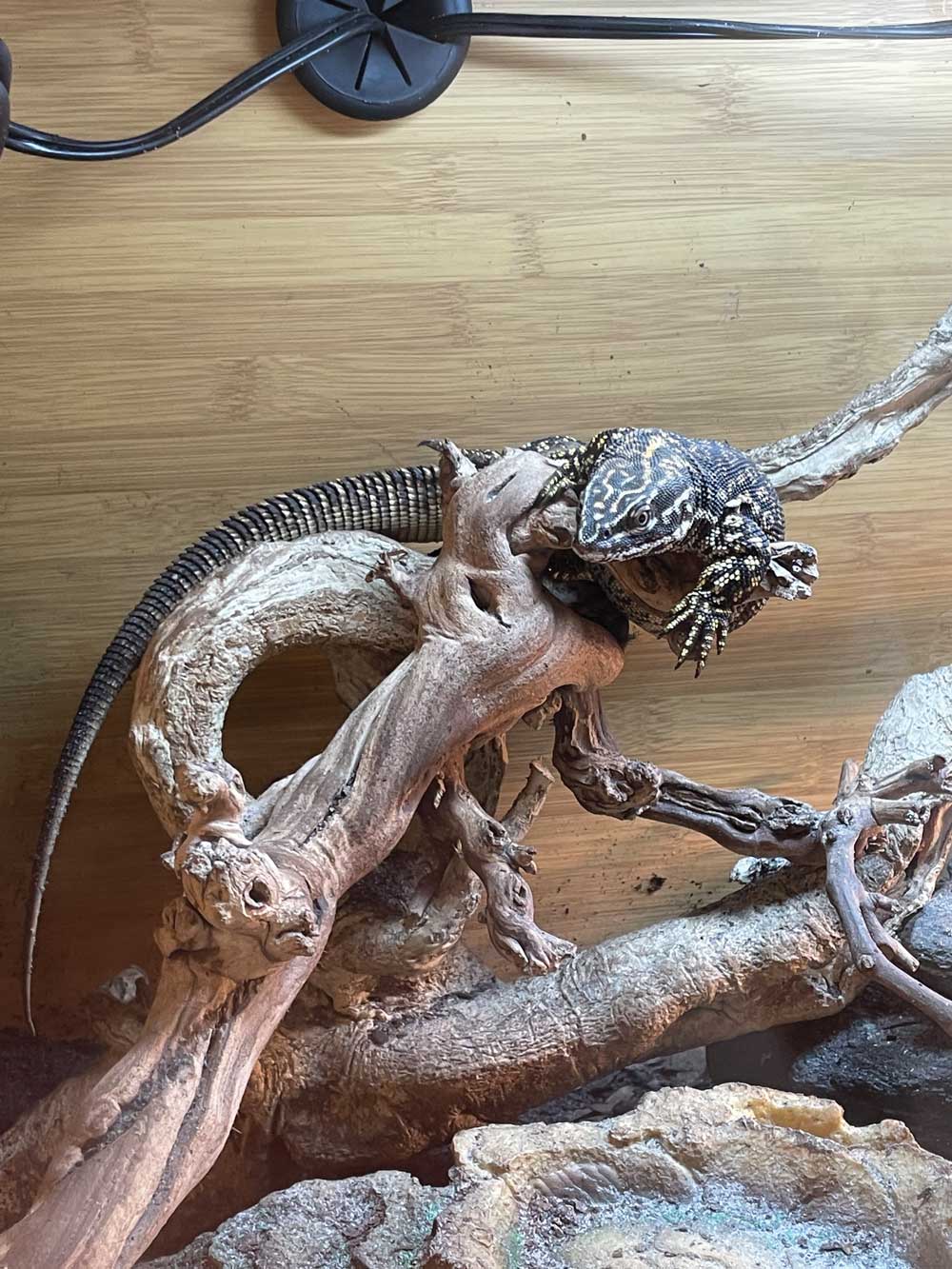
Humidity can be maintained with a deep substrate layer, water bowls positioned close to the basking spot, live plants in the enclosure, substrate cycling, and occasional misting. To help with shedding and promote additional hydration, a warm water soak once a week can be performed for 15 to 20 minutes. Water should not extend beyond the top of the Ackie’s feet, and baths should be started at shorter durations to gradually acclimate the Ackie to bathing.
Feeding Ackie Monitors
As stated previously, Ackies in the wild are predominantly insectivores with frequent consumption of smaller lizards. The most common prey items that form the diet include grasshoppers/locusts, beetles, lizards, and cockroaches.(1) Captive diets should strive to replicate similar dietary proportions, with the bulk of the diet forming grasshoppers (if legal in your area), then different roach species (Dubia, Discoid, Red Runner, etc.), beetles and their larvae, and a variety of other insects such as crickets, black soldier fly larvae, silkworms, and hornworms. Insects such as superworms and waxworms should be avoided due to excessive fat intake. I often will substitute these for giant mealworms. All insects should be gut-loaded with high calcium diets and supplemented with calcium without D3 at every meal and a multivitamin with active Vitamin A once a week. With the lack of a high quality captive-bred feeder lizard population, lizards should not be offered at this time. Additionally, non-invertebrate food items such as scrambled egg, mice, chicks, and ground turkey should not be offered. These foods are high in dietary fat and can lead to obesity if offered in sufficient quantities. If offered, these should only be given as a very rare treat and heavily supplemented.
Hatchling Ackies should be fed daily, juveniles ( up to 6 months) should be fed every other day to three times a week, and adults (1 year and up) should be fed two to three times a week. A common, and unfortunately incorrect, feeding recommendation on the amount of prey items to offer per meal is as many as the animal will take in a given period. This is done because monitors are often viewed to have higher metabolic demands compared to other lizards; however, studies show that varanids actually do not have different metabolic rates compared to other lizards.(5) Additionally, studies on wild Ackies found their fresh food consumption rate (the amount of food matter they take in a day) to be 13.2g/kg/day. (3) Thus, a 100 gram Ackie would only require 1.32 grams of food per feeding to maintain itself. I use this calculation and food scales to weigh out insect portions to ensure my lizard is getting an appropriate amount of food. This practice of weighing out meals can help reduce the risk of your Ackie developing diseases such as obesity and gout.
Starting insect colonies are an ideal and financially conscious option to provide the insects your Ackie requires through its different life stages. I maintain a discoid roach colony and have had great success maintaining them in a butterfly cage and providing maintenance food in the form of romaine lettuce, bell peppers, and other vegetable scraps to ensure the insects are healthy and propagating.
Interaction
One of the best qualities of having an Ackie as a pet is to interact with it, and many of my fondest memories with my Ackies have been when they willingly climb onto my arm and out of the enclosure. Like other monitors, Ackies are highly intelligent, thus trust must be established before you can handle your animal, especially as a hatchling.
While there is more than one way to socialize your monitor, one of the best methods I’ve seen and personally used is Kevin McCurley’s “Threads of Trust” approach. I make sure that my lizard knows that my presence in the enclosure is as natural as any of the branches or rocks. I will often place the enclosure in a room with moderate traffic. You don’t want the enclosure to be in an area with a lot of stimulation as this may stress out your animal. Conversely, if the enclosure is in a relatively quiet area, any movement through the room can cause significant stress.
I tend to let my Ackie adjust to its new enclosure for at least four to five days before interacting with it. During this adjustment phase, if I’m putting food in the enclosure, I will use tongs to do so to help build the association between tongs and food. Once my Ackie is well adjusted, I will start tong feeding and simply laying my hand in the enclosure. As I do this more, I will slowly move my hand towards the monitor with my palm facing down. I try to avoid eye contact if possible to minimize stress.
Over time, this eventually desensitizes the Ackie to touch and they often will climb on my hand. Throughout this process, you want to ensure that your monitor is making nice, long tongue flicks. This is an indicator that they are in a “thinking mode” and being curious over reactive. At this point, many Ackies will then start to wander and explore the enclosure even with my presence in the enclosure. I continue to keep my arm stationary during this phase, as I do not want my lizard to perceive I am chasing it through the enclosure. Eventually, the monitor will take its first steps on my arm and then out of the enclosure. Do not make any sudden movements and simply support your monitor as it crawls onto you. If it jumps off your shoulder, that’s okay, simply pick it up gently and allow it to walk back into the enclosure.
People will often say if trust is broken, you need to restart the whole process of socializing. I have not found this to be true. If my Ackie gets spooked, I let it go into a safe space and will either wait in the enclosure until it comes out of its hiding spot or will end that interaction and start again at a later time.
There are some important things to remember when interacting with Ackies. Every monitor is their own individual. Each Ackie I’ve owned has had a unique personality despite being the same species. Some Ackies may never tame down fully, some may take a lot longer than others, and some may not need much work at all. Go at your Ackie’s pace and do not rush it. Additionally, be mindful that although small, Ackies can still deliver a powerful bite and often will not let go willingly. These bites are often mistaking fingers for food or if they feel threatened. Appropriately reading your Ackie’s body language and not triggering your monitor’s prey drive (pulling fingers away quickly, wiggling fingers, etc) can help reduce this significantly.
Conclusion
Ackies are by far my favorite species to keep in my personal collection. They are the species that got me back into reptile keeping. Having the privilege to share my life with these incredible reptiles is something I am thankful for everyday. While the initial set up and learning curve can be steep, daily maintenance tends to be very minimal which leaves more time to thoroughly enjoy all the things that make Ackies amazing.
References
- Ki1ng , D. (2008). The Diet and Foraging Strategy of Varanus acanthurus. Biawak, 2(1), 11–17. D
- Doody, J. S., McHenry, C. R., & Clulow, S. (2017). Varanus acanthurus (Spiny-tailed Monitor Lizard). Communal nesting and commensalism. Herpetological Review, 48(1), 203–203.
- Dryden, G., Green, B., King, D., & Losos, J. (1990). Water and energy turnover in a small monitor lizard, Varanus acanthurus. Wildlife Research, 17(6), 641–646. https://doi.org/10.1071/wr9900641
- Pavón-Vázquez, C. J., Esquerré, D., Fitch, A. J., Maryan, B., Doughty, P., Donnellan, S. C., & Keogh, J. S. (2022). Between a rock and a dry place: Phylogenomics, biogeography, and systematics of Ridge-tailed monitors (squamata: Varanidae: Varanus acanthurus complex). Molecular Phylogenetics and Evolution, 173, 107516. https://doi.org/10.1016/j.ympev.2022.107516
- Thompson, G. G., & Withers, P. C. (1997). Standard and maximal metabolic rates of Goannas (Squamata: Varanidae). Physiological Zoology, 70(3), 307–323. https://doi.org/10.1086/639605

